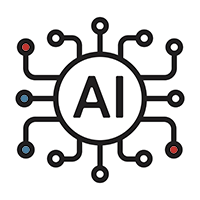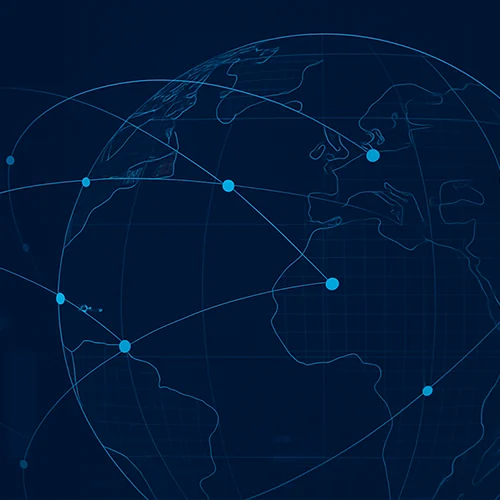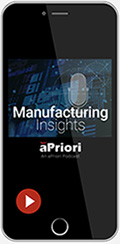March 12, 2025
The Risks of Doing Procurement As Usual

Transcript
In this third conversation between LightSource CEO Spencer Penn and aPriori’s director of product Marketing, Chris Jeznach, we hear what’s missing from the current procurement model in most manufacturing companies today. And we’ll learn how new software technology can help bridge that gap. Spencer Penn draws from his vast experience working at Tesla and then founding LightSource, where he aims to revolutionize direct procurement in manufacturing today. From this frontline perspective, he explains the gaps he’s seen in procurement and what’s possible for teams that adopt new technology to bring the procurement process into the modern AI era.
Direct vs Indirect Procurement
Chris Jeznach: Spencer, you guys are doing great things in the procurement space. What are you hearing from some of the leaders about why they’re looking for something new? What are they looking to change in the way they’re doing things?
Spencer Penn: It’s a really great question. So a few thoughts. The first thing is that, and this is a very controversial statement, LightSource is the first software platform that can actually solve the direct materials sourcing use case. Direct materials is the portion of spend that a company buys to put into their product. So this would be an automotive company buying car parts that are going into the product, or a consumer electronics company buying PCBA components. It’s going into the product, it’s getting sold to customers. By contrast, indirect procurement is anything that the company buys to consume itself, for example shrubbery for the office, or podcast microphones, or chairs. It’s not going to a customer, we’re just using it.
The challenge that I’ve noticed is that 99% of procurement software platforms are intake and process orchestration. And intake is only indirect. It’s someone in the business saying, “Hey, you know what? I need an office chair. Procurement helped me find it.” Or “I need a plant, Procurement helped me find it.” The intake problem doesn’t really gel with direct because with direct procurement, the intake is the bill of materials; it’s the product that we’re building. The volume we’re buying is coming from the EDI and material planning.
The way I describe it is that indirect procurement is like UPS when it picks up a package. It has to route it and drop it off. It’s a one-time flow, and it’s done. And then direct materials is much more like the plumbing in a building. You have to set it up right. But then it’s a continuous flow operation that’s happening all the time. And the flow is much bigger. And so the interesting thing to me is that there’s so much focus in indirect. And I think the reason in my view, is that indirect is simpler.
Chris Jeznach: In the manufacturing world, direct makes up a very large percent of your cost of goods sold. Do you think there are industry differences where some might focus more on indirect versus direct?
Spencer Penn: By asking the question, you’ve answered it. Every company has indirect, but not every company has direct. And so if you wanted to build a business and you wanted to approach the low-hanging fruit and be able to sell really broadly, you’d say, “Okay, let’s help companies buy the stuff that all companies need: laptops, office chairs, janitorial services.” With this stuff that’s really homogenous and ubiquitous, you don’t need to sharpen the pencil that much. Like at Tesla, if we were off on the laptop by 50 bucks, it really didn’t matter. If we were off by 50 bucks on the car though, there’s 10 million Model 3s over the life of the program. That’s $500 million of profit. I think it’s worth staying an extra weekend to figure that one out. Right?
There are a lot of the same problems in both indirect and direct procurement, but there’s a rank order of the importance of those problems. In the indirect space, the biggest challenge a lot of people face is just the coordination of requesting and getting the stuff. In the direct space, that is also a challenge, but the much bigger challenge is developing the right product, building the right supply base, negotiating fair prices, and then setting up a delivery system that works continuously really well.
The Problem: Disconnected Systems, or No Systems Besides Email
We often see that the problem is systems not connecting. We’re not doing an intake to procure. We’re connecting BOM to ERP, in different systems. A lot of our customers, they’ll start with a bill of materials and they will ingest that into LightSource from the PLM. So they’ll have the engineering system of record, then they’ll have LightSource, the procurement system of record. And then they’ll push out prices to the ERP as a purchase order, which is the finance system of record.
I think that in general, there are two ways I think about software. Software can either be a core backbone or it can be a nice to have or accelerant. And so when I think about what LightSource is, it’s really an operating system, a source of truth, a system of record. It is like a cockpit for the category manager to do everything that they need to.
LightSource is like how Salesforce is for a sales team: Salesforce helps sales teams find customers and sell to them, and then procurement is the same thing in reverse. We’re finding vendors and we’re buying from them. So instead of a sales motion, we’re running a sourcing motion. And just like how Salesforce isn’t primarily a payments platform, we’re not primarily a payments platform. That’s the ERP system. That’s where you create purchase orders. That’s the finance team’s dominion. And we’re also not doing the requisition because that’s oftentimes coming from the engineering team that’s developing and releasing drawings. That’s the bill of materials. And so we are connecting between the PLM and the ERP, as the procurement cockpit.
Up until LightSource, you had to do it in Excel and email. When we meet with CPOs, sometimes we have to convince them that what they think their team is doing is not what they’re actually doing. And when they go two steps below to maybe someone who’s an actual category manager, they realize that all of this digital transformation that they thought had occurred, is actually not. And when they talk to the people who are actually doing the sourcing work, they realize, oh, my goodness, we are sourcing X billion dollars of materials in negotiation over Excel spreadsheets and emails.
76% of Procurement Teams Mainly use Excel and Email
And so for us, we are trying to convince procurement that software is good. And it’s amazing because every other profession, including even the salespeople that procurement interacts with daily, they’re coming to the table with an amazing set of sales tools. And 76% of procurement teams use Excel and email as their primary tool. 86% of sales teams are using a CRM like a Salesforce or other customer 360 every day. So our goal is to really level that playing field and figure out the reasons why the tools that have existed for the last 30 years do not work and really focus on the true honest pain points that real category managers face. It has to solve the direct material use case, which none of the other tools that I had seen in my time at Tesla or since has really been able to do.
There’s this old adage: if you can measure it, you can improve it. For maybe 1 out of 10 companies, savings is their motivation and the way they measure ROI is on the basis of savings. But there are many other outcomes too that matter beyond savings. If they’re in a really competitive pricing environment, like a lot of our automotive company customers are, margin is very top of mind. If they’re in the consumer electronics space, however, cost is always important, but there’s a very important velocity of new product introduction. And so being able to actually source the product faster, bring it to market faster and actually partner with suppliers better and with less headache, that’s a totally valid goal.
There is another subset of customers that have just started popping up for us, which are customers that are worried about what’s gonna happen with Trump tariffs. And so they’re thinking, now that we’re going to have an entirely new trade regime, now we have to go back and redesign our entire supply chain. So we have to consolidate years of sourcing work potentially into six months, lest we get hit with pretty big tariffs. And so with the amount of dual sourcing, you just doubled the amount of sourcing work that you have to do. And so I would say 90% of our customers are teams that want visibility or relief of time pressure.
Top Procurement Goals:
- Cost Savings / Improve Margin
- Increase Velocity / Time to Market
- Dual Source / Adapt to Trump Tariffs
How to Speed Up the Procurement Process
Chris Jeznach: What have you found are the procurement pieces that contribute the most to time? And what are those jobs to be done that LightSource is helping to reduce the amount of time it takes?
Spencer Penn: We could look at each of the different steps. On the bid preparation side, it’s pulling in the drawings, having a baseline, having your event set up, be it 30 seconds versus three weeks of knowledge gathering across the company. The second thing is around doing internal supplier discovery, looking within your existing vendor master and figuring out who are the suppliers that we would really want to quote on this. Do we have a category grouping to support this category? And then looking externally to find new suppliers. All of those things could be done very manually or you could do it much faster in LightSource. Then it’s actually engaging the suppliers. So the suppliers just get an email from LightSource to click a link and then they have a separate interface that they get to see. They can see all of the parts and the specs and the volumes, the SKUs, the CAD files they can download, and they can respond with messages. Something shocking that we discovered was that the average sourcing is over 500 emails back and forth internally. So if you just think about even the fact that it takes like 15 minutes to draft, read and respond to an email, times the number of people who are on that thread, you’re talking about tens of thousands of hours across the team each year.
But it makes sense because let’s say you have five simple parts and you need to do a bunch of internal work to get the information about those parts. That’s maybe 10 emails back and forth internally. Then you have, let’s just call it three suppliers. So five parts, three suppliers. You have to send them a bunch of messages, prime them that they’re going to get an RFQ, get the quotes from them. They’re going to have questions, and you’re going to have to email engineering to update the spec because there are some questions. Then you send it back out to all three suppliers. There are four rounds of bidding and negotiation and conversation. Then in two months, the spec changes or the raw material price changes, you’re re-quoting and you’re renegotiating, maybe now with the incumbent awarded supplier. Quality gets involved, manufacturing gets involved, business stakeholders get involved. Cost engineering gets involved. And then long story short, you end up with 500 emails. And so LightSource just helps people do it a lot faster. And then the final thing is just data capture. If you’re collecting information from your suppliers, if you’re collecting information from your engineering team, all those negotiating points get lost. The first time most people ever touch a digital system with procurement 80 percent of the time is when they key in a purchase order in the ERP and all that says is the line item and the price that you awarded. And then all of that communication, all of that negotiation, all that rich information that you used to have, is all in folders on people’s laptops. It’s a huge disadvantage for the companies that don’t use it and it’s a huge advantage for the companies that do.








